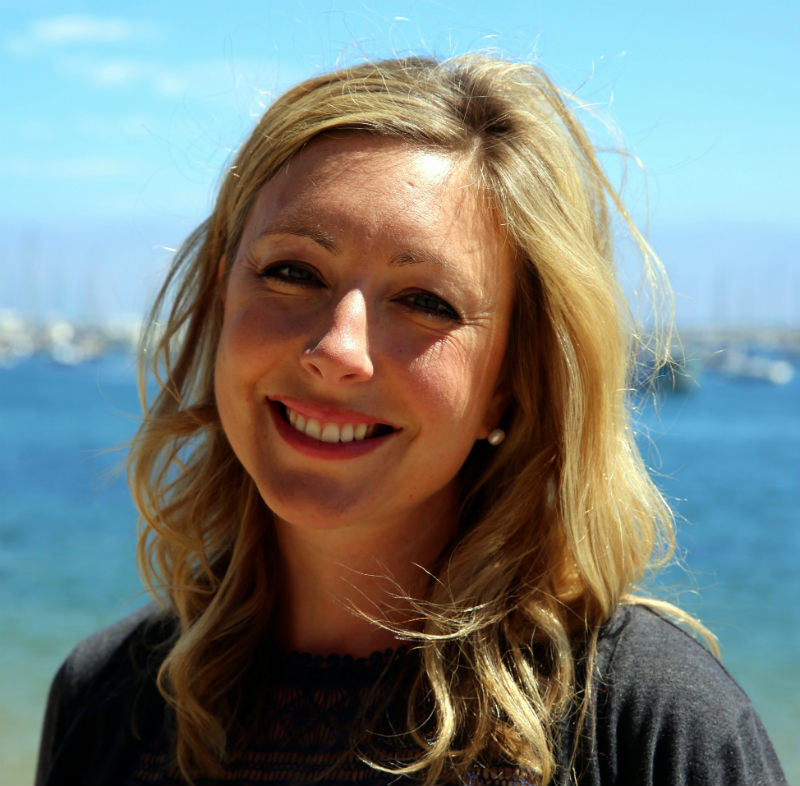
Stephanie Green, assistant professor in the Department of Biological Sciences, has been awarded a 2019 Sloan Fellowship for her research in ocean sciences. Photo courtesy of Stephanie Green.
Stephanie Green is passionate about making things right in marine ecosystems. And her work, focused on on protecting and restoring Earth's oceans from human-caused problems like biological invasion, climate change, overfishing, and habitat loss, has caught the attention of the Alfred P. Sloan Foundation.
Today, Green, assistant professor in the Department of Biological Sciences, was awarded the Sloan Research Fellowship. Nominated by their peers and chosen by a distinguished panel of senior scholars, the Sloan Research Fellows represent the next generation of leaders in the natural sciences, economics, and mathematics. These two-year fellowships, valued at $70,000, are awarded annually to researchers throughout North America in recognition of distinguished performance and a unique potential to make substantial contributions to their field.
Since the first Sloan Research Fellowships were awarded in 1955, four faculty from University of Alberta, all in the Faculty of Science, have received a Sloan Research Fellowship. The first was awarded in 1965 to William Ayer in the Department of Chemistry. The second and third were awarded in 2013 to John Davis, associate professor in the Department of Physics, and Julianne Gibbs, associate professor in the Department of Chemistry.
Hear from Green on her research and teaching programs and what it means to be a freshly minted Sloan Fellow.
What does this mean for you and your research program?
Financial support from the Sloan Research Fellowship will help my research group achieve two major research goals. First, we will increase our capacity for high performance computing to develop and test novel trait-based simulation models that reveal how ocean species' populations are likely to change under future climate scenarios. We'll apply this to understanding the extent to which economically and culturally important fish in the Eastern Pacific are likely to shift across international jurisdictions, such as between the United States and Canada.
Second, we will increase our capacity to develop 3D underwater habitat visualization technology that will allow us to investigate how seascape-scale habitat structure influences the distribution and availability of essential nutrients in coastal marine ecosystems, through novel monitoring of two large-scale manipulative field experiments in two different system types: temperate rocky reefs off the west coast of Vancouver Island at the Bamfield Marine Sciences Centre-the University of Alberta's field station-and tropical coral reefs off of the Florida Keys.
Tell us about your research program.
My lab studies the causes and consequences of biodiversity loss in marine ecosystems, with the goal of developing science-based solutions to conservation and restoration challenges. We use a range of methods in the lab and field-including behavioural observations of animals, manipulative field experiments, and simulation models-to understand how human-caused problems like biological invasion, climate change, overfishing, and habitat loss are altering species interactions within marine food webs. Some major questions that we ask is, "What will future ocean ecosystems look like and how will they function in the face of ongoing human caused change? How can we design conservation and restoration interventions to protect key ecological functions and species in these systems?" Our work takes place in close collaboration with university, government, NGO, and citizen scientists throughout the Caribbean, US, and Canada.
What inspired you to enter this field?
Sustaining biodiversity within ocean systems is vital for our societies and economies globally, including here in Alberta. (When did you last eat fish for dinner?) Marine species supply protein for billions of people world wide, produce nearly half of the oxygen on our planet, and are key sources of pharmaceutical compounds. Much of our research focuses on fishes, which are only the most biodiverse and economically important groups of species in ocean systems. Although I thought my life path might include law school, a grade 10 field trip to the Bamfield Marine Science Station (where I now teach University of Alberta field courses!) went a long way to re-directing my path towards studying and protecting nature as a scientist.
Tell us about your teaching.
I teach Marine Population Ecology and Dynamics (MSC 439), which is offered by the University of Alberta as part of the Bamfield Marine Sciences Centre fall program. The program affords undergraduate students from Bamfield's five partner institutions (including University of Alberta) to study for a full semester at the coast, where they take five courses that contribute credit towards their degree.
I feel so privileged to have students join me in the mystery, discovery, and wonder that is learning about ecology and conservation science. Developing scientific and critical thinking skills helps you understand the world around you and make more informed choices-- whether you choose to go on and become a professional scientist yourself, or any other career. Personally, I get so much energy from my students and learn so much from them too.
What brought you to the University of Alberta?
As a Canadian who spent four years conducting research in the United States, I am delighted to return "home" as a faculty member at the University of Alberta. As a marine scientist, I am especially excited about building a research and teaching program at the Bamfield Marine Sciences Centre, our field station on the rugged and beautiful Pacific Coast of Vancouver Island. The University of Alberta is a world-class university in an extremely friendly city, and I am very excited to be here.
You can learn more about our research on my website or follow our science adventures on Twitter.